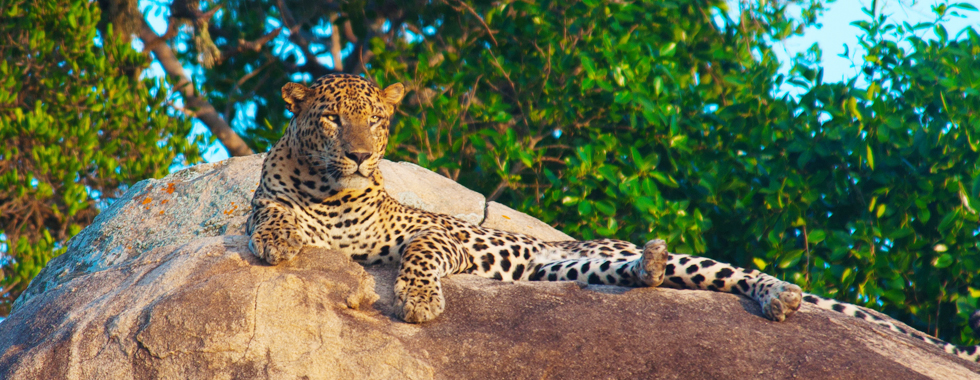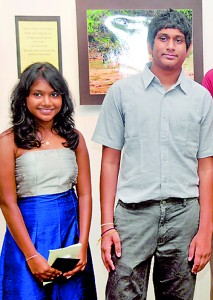Leopards leap from the pages as do other wildlife
View(s):The last few years have seen a number of books published in the portfolio genre on Sri Lankan wildlife. My first impressions are that this is one of the best. A good combination of clean, crisp images and a simple but elegant design allow the images to speak for themselves. The images are stunning. Not all of course, I would not wish to exaggerate. But so many of them are so good, that it’s easy to be drawn in through the whole book.
On the frontispiece, a leopard drinking water makes eye contact with the reader. There is an edginess, a tension, which reminds the reader that to see the wild in this way is a privilege. A privilege we must hold onto for future generations. The next wildlife image shows a leopard sniffing a scent mark on a Wara plant. This together with other images show that the photographers have been alert to capturing behaviour and not only beautiful portraits. The behaviour captured on camera ranges from mating Ruddy Mongooses, a  Crocodile carrying away prey, aggression between Jackals to a comic image of a Sloth Bear that looks as if it is on its first ice skating lesson. The variety means that it does not become another leopard book, although there would be no reason not to be defensive and not to have billed this as another leopard book. There is a breathtaking array of jaw droppingly stunning images of leopards. A battle scarred male close up, cubs in a playful chase atop a rock and leopards stretching and rolling, or just being watchful. Leopard will be leopards and they carry this book. I can’t think of a wildlife photographer who would see this book and not want to go on leopard safari in Sri Lanka. It’s hard to believe that the island was not branded for leopard safaris until 2002.
Crocodile carrying away prey, aggression between Jackals to a comic image of a Sloth Bear that looks as if it is on its first ice skating lesson. The variety means that it does not become another leopard book, although there would be no reason not to be defensive and not to have billed this as another leopard book. There is a breathtaking array of jaw droppingly stunning images of leopards. A battle scarred male close up, cubs in a playful chase atop a rock and leopards stretching and rolling, or just being watchful. Leopard will be leopards and they carry this book. I can’t think of a wildlife photographer who would see this book and not want to go on leopard safari in Sri Lanka. It’s hard to believe that the island was not branded for leopard safaris until 2002.
The book is not just leopards though and it has chapters dedicated to elephants and marine wildlife. Many people still don’t know that Sri Lanka has the largest annually recurring concentration of wild elephants. Most people would imagine this to be in Africa. The images of the jostling herds at Minneriya and the endearing picture of the two baby elephants protectively flanked by the herd, will help to get the message out.
The short section on whale and dolphin begins with a dramatic image of a pod of Pantropical Spotted Dolphins porpoising across a double page spread followed by some remarkable images including two Blue Whales close to each other. It is good to have this mix of terrestrial and marine as it all helps to reinforce other key messages such as that Sri Lanka is the Best for Blue Whale, something publicised only as recently as May 2008. The Bryde’s Whale photographed off Trincomalee is one of the best images I have seen taken off Sri Lanka. It is not uncommon, but I have never found them curious and willing to approach boats as the Blue Whales do.
The chapter on elephants merges into a chapter on birds which has some very strong images. The Green Bee-eater with a Green Skimmer dragonfly in its mouth, the White-browed Fantail mobbing a Crested Hawk-eagle are not only sharp, striking and well composed images but capture important behaviour.

The young photographers: Ashvini Jayatilake and Dimitri Goonewardena
At the start and the end are two prefaces and a brief bio on the two photographers. These pictures are also very pleasing portraits of two promising young photographers who live an enchanted life, growing up in the best all-round wildlife destination in the world. It is only now in the tail end of the review that I mention that the two photographers Dimitri Goonewardena and Ashvini Jayatilake are two young people, aged 19 and 15 respectively. I felt no reason to mention this before as the images are as good as what I have seen of experienced adult photographers. This is not to say that Sri Lanka is so disproportionately rich in wildlife that anyone can take good pictures of wildlife. It is true that it is easy to take good pictures of wildlife in Sri Lanka. But to be consistent and to build a portfolio of this standard, skill is also required. I have no doubt that both have this in abundance.
I did have the opportunity of being in Yala once in the company of both Ashvini and her father Chitral Jayatilake. I noticed how Ashvini works totally independently of her father Chitral and shoots away with the same instinct to get a shot I have seen in Chitral Jayatilake, himself a well-known photographer. I suspect some of this is a hereditary trait as with sporting abilities and further enhanced by mentoring.
Dimitri also pays tribute to Chitral who had coached him. Chitral has over the years engaged in many activities from organising workshops to photography competitions to encourage youngsters to take up wildlife photography. This book is also about the passing of the baton to a younger generation and more specifically with the Jayatilakes from grandfather to father and to daughter. In doing so, generations to come will also learn to see the wild beauty around us.
The outside back cover carries a comment by Rohan Pethiyagoda who overturned the notion that Sri Lanka was well explored for its biodiversity. Pethiyagoda has been a source of encouragement to Chitral as has more lately Jonathan and Angela Scott who have written the foreword. The Scotts foreword is reflective on what images mean, why books are precious and why photographs sometimes need no words to describe them. And this book is all of that, precious, needing few words and carrying the hope that there will be many more children who will grow up experiencing the wild.
| Book facts
Growing in the Wild by Goonewardena, G. & Jayatilake.A. (2013). |
Growing in the Wild is available at Odel book store, Barefoot book store and Gandhara book store.



